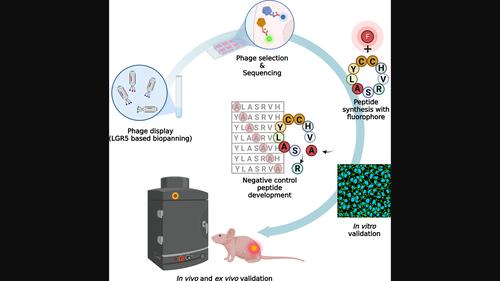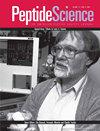Development and validation of cyclic peptide probe for gastric cancer based on phage display technique
IF 1.5
4区 生物学
Q4 BIOCHEMISTRY & MOLECULAR BIOLOGY
引用次数: 0
Abstract
Cancer-targeting diagnostics should have a sensitive and specific binding affinity. To achieve this, biomarker development is critical. This study aimed to develop and validate a 7-mer cyclic peptide probe that can target gastric cancer. We developed this probe based on LGR5 (leucine-rich repeat-containing G-protein coupled receptor 5)-specific targeting, which is a marker for gastric cancer stem cells. An LGR5 targeting peptide sequence that was developed using phage display technology resulted in a cyclic peptide, C-YLASRVH-C (named YLA). We conjugated this peptide with fluorescent probes to validate its specific targeting ability for gastric cancer. The fluorescence-labeled YLA peptide exhibited 3.0-fold higher fluorescence intensity in a gastric cancer cell line (MKN45) than it did in a normal cell line (CCD841 cells). In contrast, pancreatic and colorectal cancer cells did not show significant fluorescence intensity with the YLA peptide. To verify its tumor-targeting affinity, we developed a control peptide, C-YLASAVH-C (named YLASA) using an ALA scanning experiment. Whole-body imaging of a gastric cancer xenograft model showed higher fluorescence intensity of tumors in the YLA peptide group than in the control peptide group. Moreover, ex vivo imaging of tumor tissues exhibited 6.8-fold higher fluorescence intensity in the YLA peptide group compared to that in the YLASA control peptide group. In conclusion, we confirmed that the YLA peptide probe functions as a specific diagnostic probe for gastric cancer. We anticipate that it will play a theranostic role through further development.

基于噬菌体展示技术的胃癌环肽探针的开发与验证
癌症靶向诊断应该具有灵敏和特异的结合亲和力。为此,生物标记物的开发至关重要。本研究旨在开发和验证一种可靶向胃癌的 7 聚体环肽探针。我们基于LGR5(含亮氨酸丰富重复的G蛋白偶联受体5)特异性靶向开发了这种探针,LGR5是胃癌干细胞的标志物。利用噬菌体展示技术开发的 LGR5 靶向肽序列产生了环状肽 C-YLASRVH-C(命名为 YLA)。我们将该肽与荧光探针共轭,以验证其对胃癌的特异性靶向能力。荧光标记的 YLA 肽在胃癌细胞系(MKN45)中的荧光强度是正常细胞系(CCD841 细胞)的 3.0 倍。相比之下,胰腺癌和结直肠癌细胞对 YLA 肽的荧光强度不明显。为了验证其肿瘤靶向亲和力,我们利用 ALA 扫描实验开发了一种对照肽 C-YLASAVH-C(命名为 YLASA)。胃癌异种移植模型的全身成像显示,YLA 肽组的肿瘤荧光强度高于对照肽组。此外,肿瘤组织的体外成像显示,YLA 肽组的荧光强度是 YLASA 对照肽组的 6.8 倍。总之,我们证实了 YLA 肽探针具有胃癌特异性诊断探针的功能。我们预计,通过进一步开发,它将发挥治疗作用。
本文章由计算机程序翻译,如有差异,请以英文原文为准。
求助全文
约1分钟内获得全文
求助全文
来源期刊

Peptide Science
Biochemistry, Genetics and Molecular Biology-Biophysics
CiteScore
5.20
自引率
4.20%
发文量
36
期刊介绍:
The aim of Peptide Science is to publish significant original research papers and up-to-date reviews covering the entire field of peptide research. Peptide Science provides a forum for papers exploring all aspects of peptide synthesis, materials, structure and bioactivity, including the use of peptides in exploring protein functions and protein-protein interactions. By incorporating both experimental and theoretical studies across the whole spectrum of peptide science, the journal serves the interdisciplinary biochemical, biomaterials, biophysical and biomedical research communities.
Peptide Science is the official journal of the American Peptide Society.
 求助内容:
求助内容: 应助结果提醒方式:
应助结果提醒方式:


